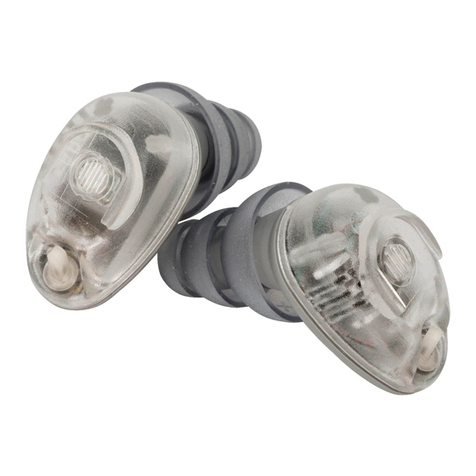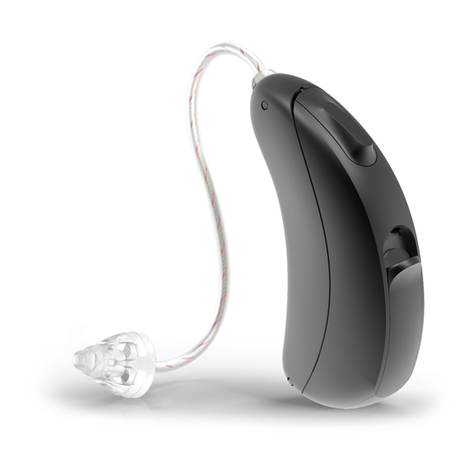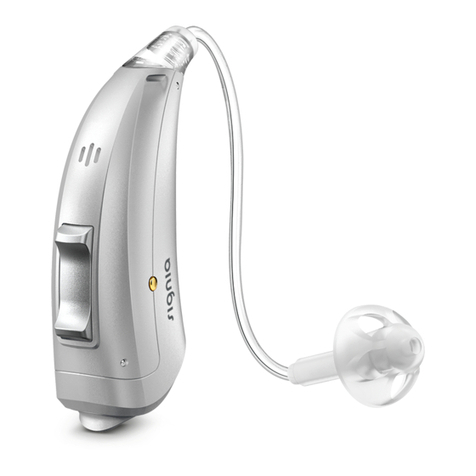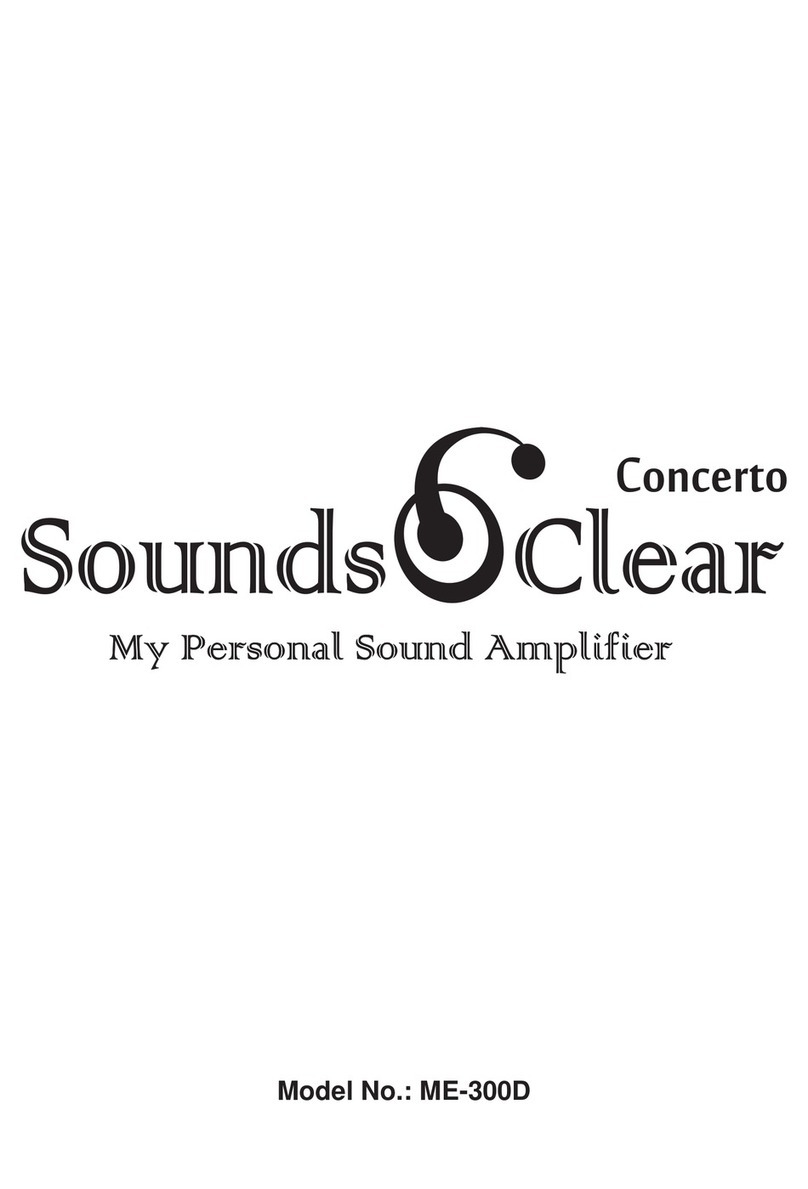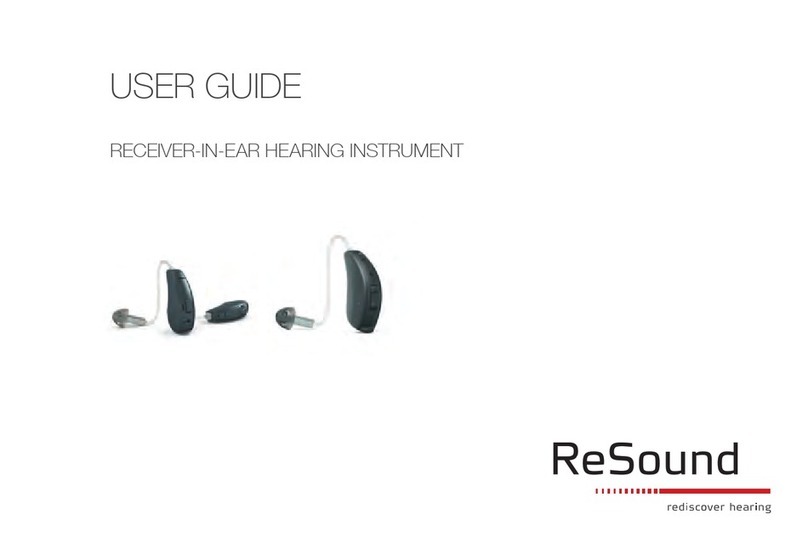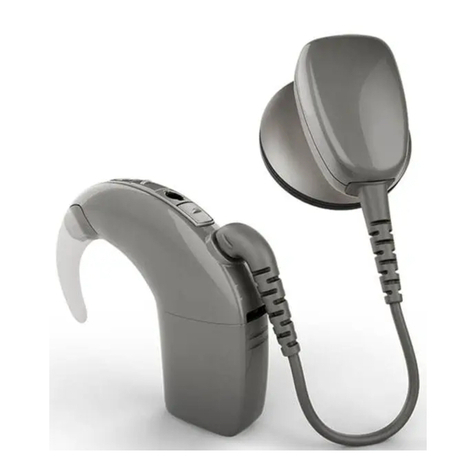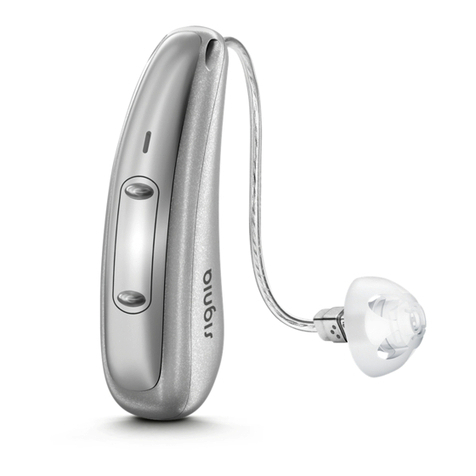SpeechVive SV1001R User manual

Reviving Speech and
Improving Lives

About SpeechVive™
1
1-800-392-3309
www.speechvive.com
Device Model Number:
SV1001R & SV1002L

Register your SpeechVive
2
Registering your SpeechVive will link your
product with important information regarding
proof of ownership, warranty service, and
recall notifications.
You will be asked to provide:
Your contact information
SpeechVive specialist
Serial #
To Register:
Online:
www.speechvive.com/register
Complete and mail the
enclosed postcard
OR

Table of Contents
3
Welcome. . . . . . . . . . . . . . . . . . . . . . . . . 5
Indications for Use . . . . . . . . . . . . . . . . . 6
SpeechVive Components . . . . . . . . . . . . 7
Quick Start Guide . . . . . . . . . . . . . . . . . . 9
Attaching Silicone Ear Tips . . . . . . . . . . 10
Your Charging Station . . . . . . . . . . . . . 11
Charging Your SpeechVive . . . . . . . . . . 12
Wearing Your SpeechVive . . . . . . . . . . .13
Storing Your SpeechVive . . . . . . . . . . . .14

Table of Contents
4
SpeechVive Care and Maintenance . . . .15
Cleaning the Silicone Ear Tip. . . . . . . . . 16
Frequently Asked Questions . . . . . . . . . 17
Tips for Better Communication . . . . . . . 19
Troubleshooting . . . . . . . . . . . . . . . . . . . 20
Warranty and Service Information. . . . . 21
Technical Information . . . . . . . . . . . . . . 22
Hazards and Warnings . . . . . . . . . . . . . .24

Welcome
5
Dear SpeechVive User,
On behalf of our entire organization, I want to
welcome you to the SpeechVive family.
Our goal is to provide a quality technology that
helps you communicate more effectively and stay
connected to family and friends. It is our privilege
and honor to provide you with a solution that gives
you your voice back.
We welcome your feedback and suggestions.
Sincerely,
Steve Mogensen, CEO
SpeechVive, Inc
smogensen@speechvive.com

Indications for Use
6
The SpeechVive device provides an audible cue to
automatically trigger the wearer to speak louder
and more clearly.
Low volume
Slurred speech
Speech rate changes
Hoarse/rough voice
The SpeechVive is a medical device. It should only be
used for the intended application. Patients should be
followed by a specialist trained for the SpeechVive
device and speech/voice disorders.
SpeechVive is a prosthetic device that augments
the laryngeal and respiratory system. It provides
more intelligible speech for people with symptoms
of hypokinetic dysarthria.

SpeechVive Components
7
1- Power Cord
2- Silicone Ear Tips
3- Charging Station
4- Cleaning Tool
5- SpeechVive Device

SpeechVive Components
8
1-Bridge
2- Ear Piece
3- Silicone Ear Tip
4- Body

9
1. Attach a Silicone Ear Tip
2. Connect your Charging Station
3. Charge your SpeechVive
4. Wear your SpeechVive
5. Store your SpeechVive
Quick Start Guid

10
Attaching Silicone Ear Tips
Line up the guides on the back of the silicone
tip with the keyhole slots on the earpiece.
Gently push the silicone tip into the earpiece
and turn the tip 90° clockwise to lock it into
place.
Your SpeechVive kit includes small,
medium, and large silicone ear tips.
Select the size most appropriate for your
ear. The ear tip should rest gently over the
ear canal, but not inside of it.
If you require assistance selecting the
appropriate size, contact your SpeechVive-
trained specialist.

11
Your Charging Station
Plug the end of the power cord that does not
have prongs into the backside of the charging
station.
Insert the prongs into a household outlet.
The light on the front of the charger will turn
blue.

12
Charging Your SpeechVive
Place the SpeechVive in the cradle of the charger.
The body of the SpeechVive should be toward the
back of the charger with the earpiece toward the
front of the charger.
Close the lid.
When the SpeechVive is placed in the charger
correctly, the light will turn amber (charging) or
green (fully charged.)
Charge your SpeechVive daily

13
Wearing Your SpeechVive
Place the ear tip in the conch of the ear.
Gently secure the body of the SpeechVive
snugly behind the ear, ensuring that the bridge is
positioned between your ear and head.
Correct placement of the SpeechVive over the ear
1- Body, 2- Bridge, 3- Conch of the Ear

14
Storing your SpeechVive
Storing your SpeechVive in the charging station
with the lid closed will maintain optimal battery
performance.
Keep it out of the reach of children and pets. The
small pieces can pose a choking hazard.
WARNING
Moisture will damage your SpeechVive.
Do not wear your SpeechVive in wet/moist
environments.
Store in a cool, dry place.

15
SpeechVive Care and Maintenance
Inspect the silicone tip for earwax and moisture
accumulation.
Ensure there are no cracks, hardening or changes in the
silicone tip color. If there are changes, contact
SpeechVive to order replacement ear tips.
Do not use soap, cleaning detergents, or solvents to
clean the earpiece or device.
To order additional ear tips:
Small: Part #SV1008
(Plantronics-81292-01)
Medium: Part #SV1007
(Plantronics- 81292-02)
Large: Part #SV1006
(Plantronics- 81292-03)
Contact SpeechVive
1-800-392-3309

16
Cleaning the Silicone Ear Tip
To remove the silicone tip:
Gently push the silicone tip inward.
Turn the tip counterclockwise 90°.
Gently pull the silicone tip free of the earpiece.
Use the cleaning tool to gently scrape ear wax
from the inside of the silicone tip.
Use a soft, dry cloth to clean the outside of the
silicone tip and to clear excess debris from the
device.
Place the silicone tip back into the earpiece for
use.
To clean the silicone tip:
WARNING
Only use the cleaning
tool for the silicone
earpiece, not for the
SpeechVive device.
Do not insert the
cleaning tool in the ear.

17
Frequently Asked Questions
1. How often should I wear my SpeechVive?
It is recommended that you wear your SpeechVive every
day during times when you will be talking. Wear it at
least 3 hours a day. For best results, read aloud for
approximately 30 minutes, 5 days a week to ensure
regular practice with the SpeechVive. Follow the
recommendations of your SpeechVive-trained specialist.
2. Can I wear my SpeechVive everyday?
Yes, it is recommended that you wear your SpeechVive
everyday for best results.
3. Do I have to wear my SpeechVive
continuously?
No, you can wear the device as needed during the day.
4. Can I wear my SpeechVive to bed?
No. You could damage the device or cause pain and
discomfort to your ear.
5. How often do I need to charge my
SpeechVive?
Charge your SpeechVive every evening when you
are finished using the device. It may stay in the charger
with the lid closed overnight or when not in use.

18
Frequently Asked Questions, continued
6. How do I know when my SpeechVive is fully
charged?
The light on the charging station will turn green when
your SpeechVive is fully charged. A full charge takes
approximately 2 hrs.
7. What should I do if my SpeechVive stops
working?
First, make sure your SpeechVive is fully charged. If it
is, make an appointment with your SpeechVive-trained
specialist for troubleshooting. The specialist may be
able to fix the issue. If not, you will need to contact
SpeechVive, Inc for service.
8. Is the SpeechVive a masking device?
No. A masking devices uses a noise stimulus to cover
up the perception of a sound (like ringing in your ears
caused by tinnitus.) The SpeechVive is not designed for
masking; therefore, no effect should be expected.
9. Is SpeechVive a hearing aid?
No. A hearing aid is designed to amplify sound to
make sound more audible to a person with hearing loss.
The SpeechVive is not an auditory amplifier and no
effect should be expected.

19
Tips for Better Communication
When possible, choose a quiet environment for
conversations.
Notify your communication partner that you are about to
speak. For example, call their name to get their attention
before beginning to speak.
Let your communication partners know that they need to tell
you if they do not understand what you are saying. The
sooner the communication breakdown is recognized, the
easier it is to repair.
Plan communication when your partner is focused on
communicating.
Use multiple strategies for clarifying your message when a
communication breakdown occurs (i.e. repeating, pointing,
and gesturing).
If possible, communicate face-to-face with others.
Tips adapted from: Yorkston,
K.M., Beukelman, D.R., Strand,
E.A., and Bell, K.R. with Hustad,
K.C. (1999). Optimizing
Communication Effectiveness:
Bringing It Together, Management
of Motor Speech Disorders in
Children and Adults (pp. 483-541).
Austin, TX: Pro-Ed.
This manual suits for next models
1
Table of contents
Popular Hearing Aid manuals by other brands
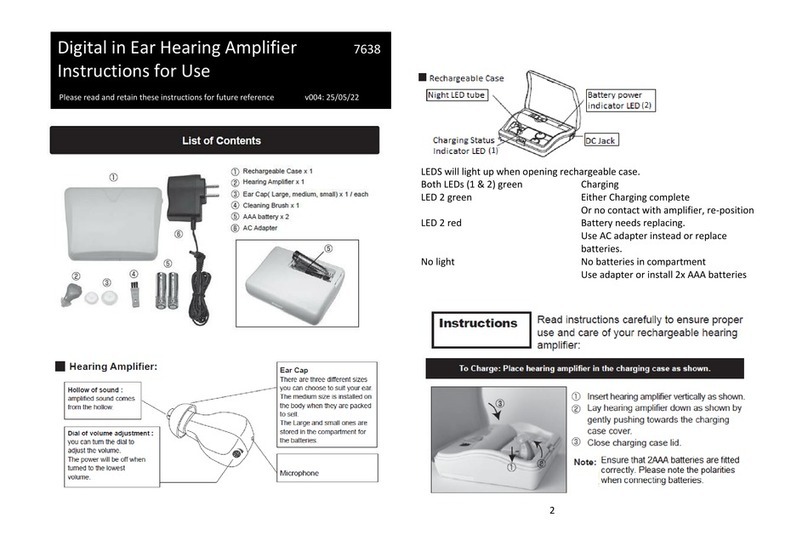
Coopers of Stortford
Coopers of Stortford Digital in Ear Hearing Amplifier Instructions for use

Camplicomms
Camplicomms HC-200 user guide
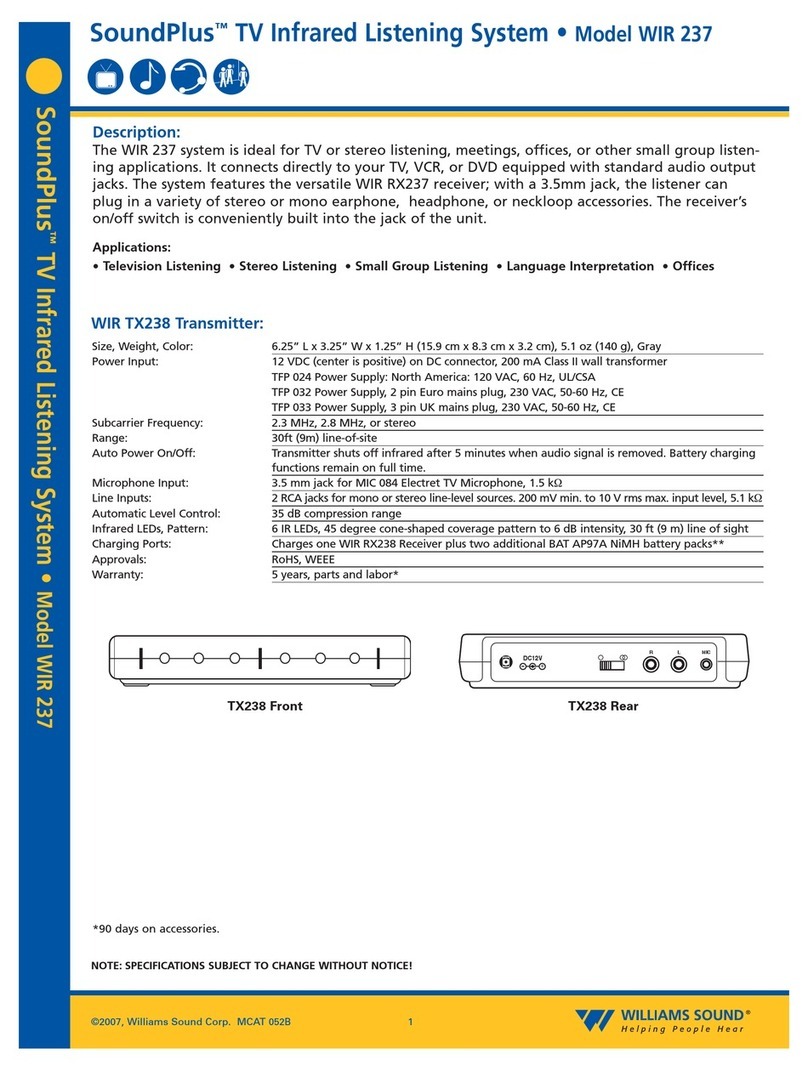
Williams Sound
Williams Sound SoundPlus WIR 237 Specification sheet
oticon
oticon connectline microphone Product information

BTE
BTE HI Getting started
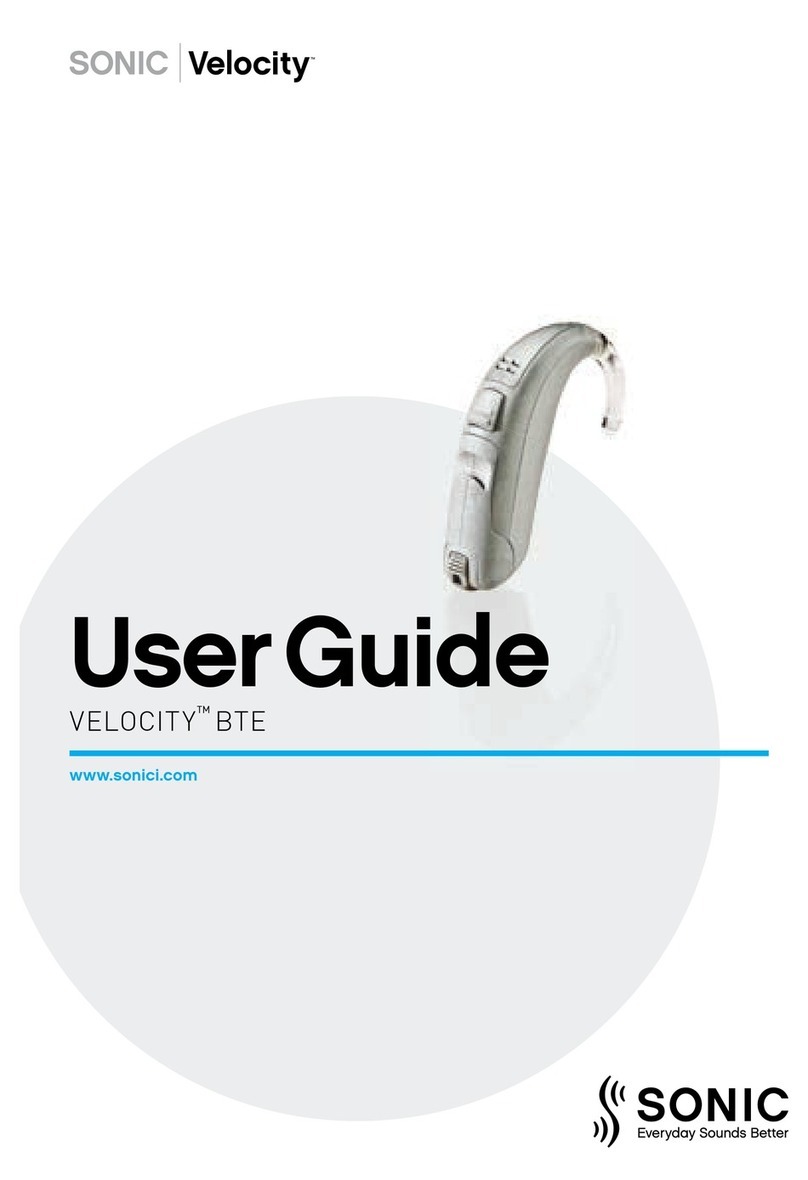
Sonic
Sonic VELOCITY BTE user guide
